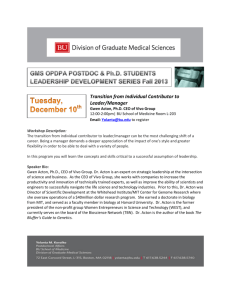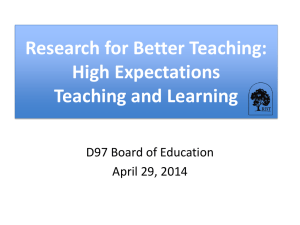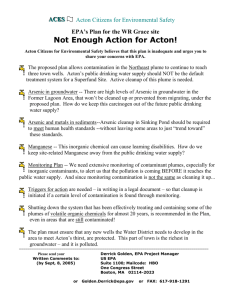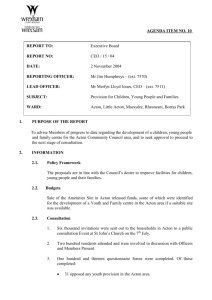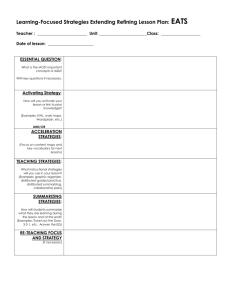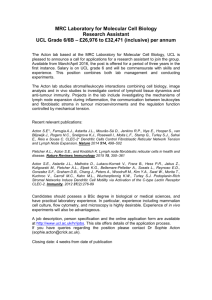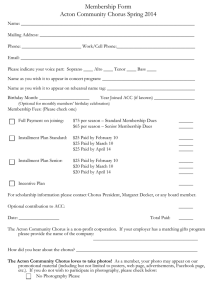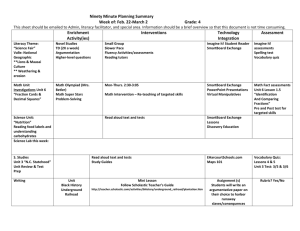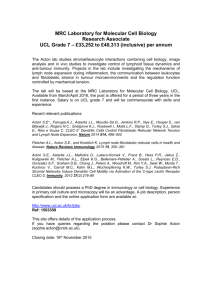Content Teams & Error Analysis: Data-Driven Re-teaching
advertisement
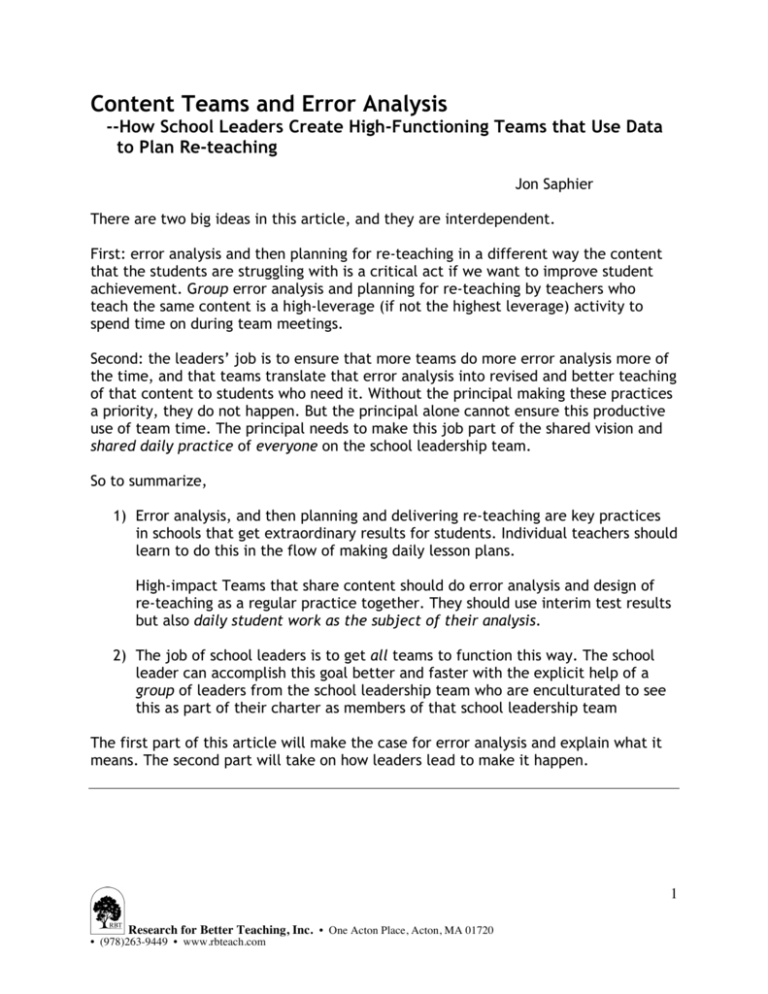
Content Teams and Error Analysis --How School Leaders Create High-Functioning Teams that Use Data to Plan Re-teaching Jon Saphier There are two big ideas in this article, and they are interdependent. First: error analysis and then planning for re-teaching in a different way the content that the students are struggling with is a critical act if we want to improve student achievement. Group error analysis and planning for re-teaching by teachers who teach the same content is a high-leverage (if not the highest leverage) activity to spend time on during team meetings. Second: the leaders’ job is to ensure that more teams do more error analysis more of the time, and that teams translate that error analysis into revised and better teaching of that content to students who need it. Without the principal making these practices a priority, they do not happen. But the principal alone cannot ensure this productive use of team time. The principal needs to make this job part of the shared vision and shared daily practice of everyone on the school leadership team. So to summarize, 1) Error analysis, and then planning and delivering re-teaching are key practices in schools that get extraordinary results for students. Individual teachers should learn to do this in the flow of making daily lesson plans. High-impact Teams that share content should do error analysis and design of re-teaching as a regular practice together. They should use interim test results but also daily student work as the subject of their analysis. 2) The job of school leaders is to get all teams to function this way. The school leader can accomplish this goal better and faster with the explicit help of a group of leaders from the school leadership team who are enculturated to see this as part of their charter as members of that school leadership team The first part of this article will make the case for error analysis and explain what it means. The second part will take on how leaders lead to make it happen. 1 Research for Better Teaching, Inc. • One Acton Place, Acton, MA 01720 • (978)263-9449 • www.rbteach.com Error Analysis and Teams that Do So One of the highest leverage activities found in schools that raise student achievement is the following: lay out student work – either the results of yesterdays class work or the item analysis of an interim assessment. Then identify where students are struggling and which students did the struggling. Then try to figure out what the students might have been thinking to make the errors. Then use those insights to design re-teaching lessons for those who need it. The sequence is this: 1. What might the students have been thinking to make this error? What are our hypotheses? 2. How can we find out which of these hypotheses is true? 3. What different teaching strategies could we use to “fix” or undo whatever led to this error and help students solidify their skills and concepts? 4. How are each of us going to plan and manage time and tasks in class so that we’ll get fifteen minutes (or whatever it takes) to re-teach the skills and concepts. [Target: at least 2 times a week for groups of students who don’t have it.] 5. How can the team help? Determine whether there is a way to share knowledge, skill, or students to benefit both students and colleagues. Imagine the following. During their Common Planning Time at 11:10 AM, four fourth grade teachers are looking at the item analysis below from an interim assessment. It shows the test item and the data on how ninety-nine students responded. Thirty-nine students had the correct answer (B) and sixty didn’t. The tally was generated by Kim Marshall, at the time principal of the Mather Elementary School in Boston. Teacher A: Twenty-seven students incorrectly chose answer C. What might they have been thinking to pick that one? Teacher B: Perhaps they did not know that they need to “zero” a linear object on a ruler when measuring its length. I find this is quite common in elementary kids. And rulers don’t help, since many of them place the first hash marks a quarter inch inward from the physical edge of the ruler. Teacher A: …or maybe it’s about creating an imaginary zero at any point on the ruler, but then counting up in inch units to the end of the object. Teacher C: So maybe the problem is the children don’t know they have to put the beginning of the object at the exact zero point on the ruler and that zero point might not be the physical left end-point of the ruler. Teacher A: Oh, I don’t know. I think maybe they were just careless and didn’t look carefully enough to notice that the truck in the picture was placed at 3 inches instead of 0. 2 Research for Better Teaching, Inc. • One Acton Place, Acton, MA 01720 • (978)263-9449 • www.rbteach.com Teacher B: Or maybe some children are making both of these errors. Figure 1 Fourth-Grade Mathematics Question Source: Massachusetts Comprehensive Assessment System: Release of spring 2001 test items. Teacher C: So for re-teaching we will need to think about what fix-it strategies we could use for tomorrow … Teacher B: And they should be quite different depending on which error the student was making. Teacher A: Let’s work out what to do for the children who don’t know or don’t remember to zero the object on the ruler. Teacher C: We could make up some pretend rulers on oak tag where the first hash mark was at different distances in from the edge. We could cue the kids that they had to zero the object (say, we will have different size blocks for them to measure) and tell them that it won’t be easy to do because these are “trick” rulers. Teacher B: We could say you have to measure each object with a different one of the trick rulers and have the kids pass the rulers and the objects around the circle 3 Research for Better Teaching, Inc. • One Acton Place, Acton, MA 01720 • (978)263-9449 • www.rbteach.com Teacher A: Maybe put kids in groups of five. The scenario continues while these teachers analyze the thinking of children who answered C and D. (D is the “best" error. Can you tell why?). And the conversation moves to how to gather data about who made which types of error and how to manage the re-teaching. That can be done in minutes later in the afternoon by simply asking a few children to think out loud about how they did the problem. This is also a golden opportunity for the teacher to share with students how s/he went about doing error analysis in preparation for teaching students, and how students can do the same with their own work. This thinking could also be a teacher looking at her own data and planning by herself. But imagine the power if teachers had regular collaborative opportunities with dialogue like this to examine data and plan how to re-teach a concept! Embedded in the practice above are essential beliefs about how to do school: “If some of the students aren’t getting it, it is my responsibility to do something different for them.” “I have to get assessment information frequently [daily] to see when re-teaching is necessary. “If I take the trouble to do this assessment and to design re-teaching, the students who don’t get it now probably will get it.” These beliefs about student capacity show up in interactive teaching in very concrete and observable ways. They influence the spirit, the fibre, the character and commitment of the staff in the school to be persistent when the going gets tough with discouraged students or youngsters who are way behind. And they are evident in team meetings where they show up in dialog and statements one can hear. This is particularly true of the belief that all the students’ have capacity to do rigorous material at high standards, even if they are currently way behind. High-functioning teams spend much of their time on concrete issues of teaching and learning like the scenario above and like the items listed in the diagram below under the title: “Team Time Spent On:” 4 Research for Better Teaching, Inc. • One Acton Place, Acton, MA 01720 • (978)263-9449 • www.rbteach.com Figure 2 Job of the Principal It takes good leadership for a team to function like the three teachers described above: • Skills at Data Analysis …especially item analysis from common assessments and interim assessments • Concept-Analysis and Task-Analysis Skills Knowing how to dig deeply into the content with the teachers around the table so you can all surface the concepts and sub-concepts under the task/item the students are struggling with. • Generic Meeting Facilitation Skills Keeping to the agenda, getting all voices in the room, etc.. • Skills to Make it Safe …safe for faculty members to be vulnerable in front of peers… safe to invent new pedagogical representations…safe to disagree and debate… 5 Research for Better Teaching, Inc. • One Acton Place, Acton, MA 01720 • (978)263-9449 • www.rbteach.com • Skills and Courage to Face the Data and Push for Constant Measurable Improvement of Student Results Setting SMART Goals for % of students proficient; also setting more narrow goals with commitment to try certain re-teaching approaches for particular skills/concepts and comparing results afterwards… • Skills to build group norms of 1) Trust, 2) Productive Conflict, 3) Commitment to Decisions, 4) Accountability for Interpersonal Behavior, and 5) Collective Results Orientation. • Skills and Courage to Stand for Effort-Based Ability at Every Turn Confronting peers appropriately for negative comments about children’s ability How can we develop the leadership and the habits of practice in enough faculty members so teams of teachers who share content perform this way? Not by bringing in a consultant to teach them a “course.” (This is not to dump on consultants. After all, I am one.) The principal and the other members of the leadership team of the building are the only people who can accomplish this transformation; and transformation it is, because very few teams in any school function as described above, nor are there forces or supports in place to get them to do so. So let us start by redefining the building Leadership Team in a school: 1. The charter of your leadership team (that is, its purpose, its mission, its main reason for being) is to improve the teaching and learning in every classroom in the building. Its primary purpose is not management of everyday business. (The paradox, of course, is that school business does not disappear just because you have redefined the leadership team, and so has to be handled anyway. Thus alternative times and formats for necessary communication around business need to be chosen.) 2. The Leadership Team is colleagues, under the leadership of the principal, who have a common vision of what good teaching and learning look like. You make a plan of action to achieve that vision in increments, and you implement that plan together. 3. This team, working under the leadership of a clear and mission-driven principal, is the necessary condition for large scale improvement of teaching and learning. Principals can’t do it alone, however. Principals, as the instructional leaders of the building need multiple allies, many teacher leaders to improve teaching and learning. 6 Research for Better Teaching, Inc. • One Acton Place, Acton, MA 01720 • (978)263-9449 • www.rbteach.com 4. The leadership team should consist of those who have maximum access and influence over the teacher corps in the building. There are many different people who may, by virtue of their role, position, and status with their colleagues, fill this bill. One can compose a team of four to ten people from amongst: APs Dept. Chairs Instructional Specialists Coaches Team Leaders Counselors Resource/Sped teachers Lead Teachers Union Leaders ELL Coordinator Others Get the “right people on the bus.”1 5. The Principal’s first and central job is to build the Leadership Team – its charter, the skills, the cohesion, and the commitment of his/her leadership team members. It may be the main focus of the first year in a building. By the second year the leadership team meetings should evolve to a stage where the leaders are comparing notes on their leadership efforts just like we want teachers to share stories on their teaching efforts. Members are doing round table case reviews of supervision and coaching of individual teachers, problem-solving with and for each other, and functioning as a study group where they all learn new things about good teaching and learning and leadership together. The principal as the leader of this leadership team thinks of him/herself as the teacher to the group (and learner with them, of course.) Thus the principal plans these meetings just like planning a good lesson. The principal and the LT members need to have a clear image of what error-analysis and re-teaching meetings look like and sound like. Thus principals working together in a training session should be the kick-off for this work. Principals might, indeed, benefit from a formal PD course on the scenarios described above. They themselves, however, should be the “course leader” and facilitator in the ensuing stages for their own building. This is principal as “teacher” among colleagues, or principal teacher, which is the origin of the title “principal” to begin with. Each member of the Leadership Team should see, participate in, and practice leading error analysis and re-teaching meetings of teachers. At the outset the principal should have each member of the leadership team bring a packet of recent student work from a classroom (one can invite the teacher too, as an observer or a participant.) The principal leads the error analysis and re-teaching meeting just as if it were a grade level or common-subject group. Note: the principal is modeling risk-taking, not being expert at doing this, and commitment to find a way for the student(s) to learn the item. Other early-stage actions are for the principal to lead an actual grade or subject meeting into error analysis and re-teaching and have leadership team members observe and debrief with the principal, always modeling and being explicit 1 AS Jim Collins says in “Good to Great.” Research for Better Teaching, Inc. • One Acton Place, Acton, MA 01720 • (978)263-9449 • www.rbteach.com 7 that “we’re trying to learn how to do this important thing.” Then other LT members get into the cycle with other members of the Leadership Team observing. Leadership team members then move into a role of being present at all team meetings of teachers who share content. They decide differentially how strong a role to play at these meetings, depending on the level of development of that teacher team. Presence as well as intervention, guidance, and modeling productive team meetings for error analysis and re-teaching is not the only lever, but it is a most important one for influencing teaching and learning in any school. It would accelerate school improvement and good work all over the country at closing the achievement gap if the focus described here were incorporated in programs for the training and certification of school leaders. ---------------------------------------------------------------------------------------------------------- 8 Research for Better Teaching, Inc. • One Acton Place, Acton, MA 01720 • (978)263-9449 • www.rbteach.com Appendix Levels of Sophistication of Common Planning Time (CPT) Activities for teachers who teach the same content. LEVEL 0 • CPT meetings are scheduled, but teachers do not always show up or show up on time. • There are no written agendas, established group norms, or student work on the table for examination. • Conversation is about children, upcoming events like field trips, testing, etc., but rarely about the specifics of how to teach something or teach it better. • There is occasional sharing of worksheets and activity ideas. ---------------------------------------------------------------------------------------------LEVEL 1 • Teachers meet consistently 1-3 times a week. • There is a written Agenda and next steps recorded after each CPT meeting. • There are established CPT norms, but not necessarily close facilitation to ensure they are followed. • Student work is sometimes on the table at meetings. • There is discussion about student difficulties and what to do about them • There is sharing of activities, strategies, worksheets. ---------------------------------------------------------------------------------------------LEVEL 2 • There is a written agenda, facilitator, and next steps identified and recorded at each meeting. • Group norms are honored and practiced • The team has created common assessments for major benchmarks, and agrees on implementation and scoring processes. (These could be end-of-course tests, quarterly assessments, interim-assessments.) 9 Research for Better Teaching, Inc. • One Acton Place, Acton, MA 01720 • (978)263-9449 • www.rbteach.com • The CPT team establishes SMART2 goals for their students. • Administrators occasionally attend. -------------------------------------------------------------------------------LEVEL 3 • Team members establish reliability on scoring common assessments, at what to call a 1, 2, 3, or 4. • Team members make up common quizzes or formative assessments to find out how students are doing and identify problems and gaps in student understanding. They bring these back, analyze results and do error analysis together. • The team revisits and decides to re-teach key concepts, inventing new re-teaching strategies developed in detail for concepts or skills students are struggling with. • Team members disaggregate data on an assessment they gave in common and pool data on which students did well and which didn’t. Then the team regroups students across our sections to re-teach. • Discourse is focused on evidence and teachers are beginning to question one another’s ideas and practices. • Team members practice actually doing the re-teaching strategies with one another. • Team members decide in common which re-teaching strategies to try and compare results at the next meeting. • Administrators attend on occasion and participate as peers. ----------------------------------------------------------------------------------LEVEL 4 • Team members dig into concepts and sub-concepts of what they are teaching to get clearer on the relationships of concepts and sub-concepts and on what student confusions, misconceptions and necessary prior knowledge might be. • The group plans lessons together in depth and detail, including doing the activity they are asking students to do. All materials are brought to the meeting. • Adminisrators attend regularly and assist in arranging inter-visitations among teaches in the CPT group. 2 Specific: Who? What? Where? Measurable: How will the goal be measured? Attainable: Is the goal realistic, yet challenging? Results-oriented: Is the goal consistent with other goals established and fits with your immediate and long-range plans? Timebound: Is it trackable and allows for monitoring of progress? 10 Research for Better Teaching, Inc. • One Acton Place, Acton, MA 01720 • (978)263-9449 • www.rbteach.com ------------------------------------------------------------------------------------LEVEL 5 • Team members visit each others’ classrooms regularly to do focused peer observation for one another. They collect data in service of a question one of us wants answered (evidence of student learning…etc.) There is skillful debriefing of the observation and planning of next steps. • Teaching becomes public with teachers visiting each others’ classrooms regularly and providing critical feedback and suggestions. • Teachers work collaboratively with administrators to develop individual and collective professional learning goals and design support for achieving them. 11 Research for Better Teaching, Inc. • One Acton Place, Acton, MA 01720 • (978)263-9449 • www.rbteach.com
